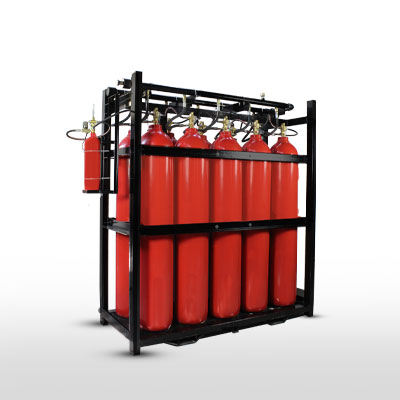Co2 System
Overview
- Agent: Carbon dioxide (CO2) is a colorless, odorless, and electrically non-conductive gas. It is widely used as a fire suppression agent due to its ability to suffocate flames.
- Uses: Commonly used in manufacturing industries, electrical facilities, generator rooms, engine rooms, and other areas that require rapid and effective fire suppression.
Features
-
Rapid and Effective Suppression:
- CO2 works by reducing the oxygen concentration in the air to a level where combustion cannot continue.
- Provides quick fire suppression, helping to minimize fire damage.
-
Equipment Safety:
- As a clean gas, CO2 leaves no residue after discharge, meaning there is no need for cleanup post-fire.
- Safe for use in areas with sensitive equipment.
-
Design and Installation:
- The system can be designed for total flooding or local application, offering great flexibility in protecting different areas.
- Uses a network of pipes and nozzles to distribute the gas throughout the protected area.
-
Safety Considerations:
- It is crucial to note that CO2 can be hazardous to life at high concentrations as it reduces the available oxygen for breathing.
- Systems typically include alarms and detection devices to ensure the area is evacuated before gas discharge.
Applications
- Generator and Engine Rooms: Protects vital equipment from fire damage.
- Manufacturing Industries: Provides protection for machinery and industrial equipment.
- Laboratories: Used to protect sensitive and important equipment.
- Archives and Libraries: Preserves valuable documents and artifacts without leaving residue.
Advantages
- Rapid Suppression: Provides immediate fire suppression, reducing damage.
- No Residue: Leaves no residue, eliminating the need for post-fire cleanup.
- Cost-Effective: CO2 is a cost-effective option compared to some other suppression systems.
Installation Process
- Risk Assessment: Identify and assess the specific fire risks of the protected area.
- System Design: Design the system to meet the specific needs of the area, considering factors like room size and equipment layout.
- Installation: Install the network of pipes, nozzles, and CO2 storage cylinders.
- Commissioning: Test the system to ensure it operates correctly and effectively.
- Maintenance: Establish a regular maintenance schedule to ensure ongoing reliability and compliance with standards.
CO2 systems from CEO Deux offer a reliable and effective solution for fire suppression in industrial and commercial environments that require rapid and effective protection against fires.



Get quotation for this product